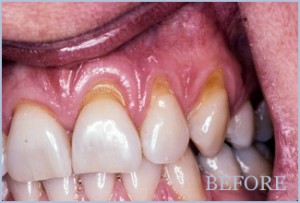Header logo
header top contact widget
Receded Gums
How NOT To Be The One With Bad Breath!
Posted on Apr 25, 2018 by William J. Claiborne, DDS MS
If you’ve ever wondered “Is my breath bad?” when in close conversations, you know it’s an uneasy feeling. We ALL know this because, when the shoe is on the other foot, being with someone who’s breath odor causes an uncomfortable wall of P-U tends to create a poor and lasting impression!
We all suffer occasionally with not-so-pleasant breath, such as after morning coffee or an onion-topped hot dog lunch. While any bad breath is unwelcome, it is not unusual on occasion. We can often pop a couple of breath mints or piece of gum in our mouths and feel we are somewhat in better shape.
However, it’s when people have frequent bad breath that concerns me, as a dentist, the most.
The root source of bad breath is oral bacteria. Bacteria are living organisms that eat, reproduce and emit waste on a consistent basis. Drinking sugary colas and a diet of high carbohydrate foods rev up bacteria reproduction even more, boosting their ability to grow and thrive.
Poor oral hygiene is the most common cause for bad breath. Not brushing and flossing adequately allows oral bacteria to reproduce, which leads to plaque.
Plaque is the sticky film you feel on teeth when you’ve missed brushing. When not removed daily, plaque forms into a cement-hard substance known to as calculus. This mass is actually a colony of oral bacteria that attaches to teeth and can no longer be brushed or flossed away.
Calculus attacks enamel and gum tissues. As the bacteria grows, it causes the gum tissues to become inflamed. This inflammation can quickly develop into gingivitis, an early form of gum disease. If not resolved fully, however, gingivitis can lead to full-blown periodontal (gum) disease.
Many people are not aware that a common symptom of gum disease is persistent bad breath. This may be accompanied by tender gums that bleed easily when brushing. As it progresses, the gums may loosen from teeth (or ‘recede’) and turn red in color.
When we perform periodontal exams, we look for signs of inflammation and redness. If signs of gum disease are present, we will recommend appropriate treatment to restore your mouth to a healthy state.
While we only recommend the most conservative treatment needed for the level of gum disease that exists, we urge prompt treatment. Gum disease only worsens without treatment and, as with anything, the sooner the problem is resolved, the less involved the process will be. Early treatment can also mean less treatment time and expense.
If gum disease is not the cause of your breath odor, another culprit may be ‘dry mouth.’ Dry mouth causes your mouth to be stale and sticky, which creates bad breath. Dry mouth can be the result of many sources. For example, it is a common side effect of many medications.
Another example of dry mouth is when you first wake up because saliva flow is minimized during sleep. For people who breath through their mouths or snore, this dries oral tissues even more. Unfortunately, this means oral bacteria are not being flushed from of our mouths and able to accumulate.
Other drying causes come from what we may eat or drink. For example, alcoholic beverages, coffee and chocolate are drying to oral tissues. For those who smoke, oral dryness is a particular challenge. Cigarette smoke contains a large number of chemicals that are severely drying.
Want to keep your breath fresh? Preventing bad breath is actually easy. It simply requires a commitment to manage bacteria levels in the mouth.
Begin with a periodontal examination and cleaning to establish a foundation of good oral health. Once your oral health is in good shape, you can keep it there through a thorough daily oral hygiene regimen, which includes:
– Brush at least twice a day for at least two minutes each time. Finish by brushing your tongue with your tooth brush to loosen embedded bacteria there. Be sure to get to the back portion of the tongue, where the majority of oral bacteria are embedded.
– Floss daily to dislodge particles caught between teeth that a toothbrush may not be able to dislodge. If you find this action difficult, consider purchasing an electronic flosser.
– Keep your mouth moist by drinking plenty of filtered water throughout the day. If you take medications that are dying, consider using an oral rinse to boost saliva flow and replenish oral moisture.
Having good oral health and ways is important to having fresh breath. Yet, it is also important to having good overall health. Call 828-274-9440 for more information or to schedule an appointment.
Proper Bite Alignment Necessary To Support Oral Health & Implant Success
Posted on Mar 27, 2018 by William J. Claiborne, DDS MS
As a Periodontist, I specialize in treating all stages of gum disease and perform a number of procedures that involve the gum tissues (including crown lengthening and repair of ‘gummy smiles‘). My specialty also includes advanced training in the diagnosis and placement of dental implants.
So, why would I be so concerned with bite alignment?
In my profession, I work with a number of general dentists and dental specialists. Together, we create a ‘team treatment’ approach designed to fulfill each patient’s unique oral wellness needs. While I do not provide orthodontic realignment services or claim to specialize in that area, I do understand the need for having properly aligned teeth.
I see a lot in an adult’s mouth that isn’t necessarily obvious to the patient, yet has a tremendous impact on overall oral health, especially in their potential to AVOID problems.
First, the position of the teeth is more important than how they come together and create an attractive smile. Teeth that become crowded or crooked tend to form tight angles that make it difficult for a toothbrush to get into.
These nooks can easily become breeding grounds for oral bacteria. The accumulation of oral bacteria can lead to the formation of cavities and the development of gum disease.

Example of gum recession
Also, know that each tooth helps to support neighboring teeth, providing an abutment to keep other teeth in their positions. This is why it is so important to replace a missing tooth.
Without it, the teeth on either side can tilt out of their proper positions. Additionally, the tooth above (or below) can grow longer. These abnormal positions of teeth can contribute to a number of issues.
When a bite is misaligned, gum recession can occur. This is due to the unnatural pull of the gums around the base of teeth. Without this tight seal, oral bacteria can more easily penetrate below the surface of the gum line. Bacteria that reaches tender tooth root segments can create decay and periodontal disease.
Another problem with improperly aligned teeth has to do with dental implants. A ‘bad bite’ can lead to problems that include night-time clenching and grinding. A dental implant is placed in the jaw bone, the same sturdy foundation as natural tooth roots enjoy. However, a newly placed implant can be put at dire risk when surrounding teeth are interfering.
A dental implant is placed in the jaw bone, which serves as a replacement tooth root. During the first 3 – 6 months, the bone is growing around it, securing it in place. It is during this time that an implant is most vulnerable to the forces that clenching and grinding exert.
However, all teeth are at risk when clenching and grinding occur – not just those attached to an implanted post. ‘Bruxing’ (as it is known) can lead to chipped, broken and fractured teeth. It can also transfer stress and strain to facial, neck and shoulder muscles.
A number of people who have frequent headaches and migraines are surprised to discover the originating source is actually their TMJ (jaw joints). This typically occurs when a bite is misaligned. This can lead to a domino effect that reaches these joints. As a matter of fact, ear ringing, dizziness and difficulty opening the mouth fully are common symptoms of TMJ disorders that people are often unaware.
So, as a periodontist, I see how bite misalignment can cause the gums to recede and also how the potential for implant success can be affected. Simply, a correct bite is necessary for good oral health. Having it can help you avoid a long list of problems.
If gum tenderness or bleeding gums seems to occur in the area of crooked teeth, then let’s evaluate the issue. Or, if you’re considering dental implants but suspect you clench or grind your teeth, we’ll discuss ways you can achieve your smile goals and protect your investment.
Call 828-274-9440 to schedule a consultation.
Men Have Room For Improvement When It Comes To Caring For Their Smile!
Posted on Feb 20, 2018 by William J. Claiborne, DDS MS
Guys – when it comes to the battle of the sexes, you’re losing when it comes to your smile! 
According to a survey by the Centers For Disease Control & Prevention (CDC), only 66 percent of males brush their teeth twice or more a day compared with 86 percent of females who do so.
The study of over 800 participants included completion of a written questionnaire on dental knowledge and oral health habits. The study, shared by the Journal of Periodontology, also included an oral exam of each participant to detect signs of periodontal disease. (https://www.perio.org/consumer/gender-differences)
Things don’t get much better when it comes to flossing, but that pertains to both sexes. Only 49 percent in the survey stated they floss on a daily basis. Even worse,1 out of 3 assumed that seeing blood in the sink when brushing is normal and were unaware it is a sign of periodontal (gum) disease.
The study also showed women as twice as likely to see their dentist for regular dental check-ups and more likely to follow through with recommended dental treatment. As a result, it was no surprise that the study revealed women had better levels of gum health with less dental plaque, calculus, and bleeding.
Men – remember that gum disease is the nation’s leading cause of adult tooth loss. If the thoughts of enduring tooth extractions and replacement decisions don’t motivate you to brush and floss more, try this image. Oral bacteria are living, breathing and eating creatures that live in our mouths. Like any living thing, what is eaten is then released through defecation. Yes, these organisms do this in your mouth! If you’ve ever wondered about bad breath, keep this vision in mind and, if nothing else, that alone should motivate you to brush more often!
Also, be aware of the signs and symptoms of gum disease, which is an over-accumulation of bacteria in the mouth. Initial symptoms are tender or swollen gums, seeing blood in the sink when brushing, and frequent bad breath. However, keep in mind that some signs don’t emerge until gum disease is running rampant.
As the disease worsens, you may experience persistent bad breath, gums that turn red in color (versus a healthy pink) and pus-filled pockets that form at the base of teeth. Untreated, you’ll eventually experience gums that pull away from teeth and teeth that loosen and may require removal.
It takes mere minutes each day to avoid this disease. And it’s easy and inexpensive. Use a soft to medium toothbrush and brush for two minutes twice daily. Brush in a swirling motion rather than scrub back and forth, which wears down tender gum tissues. After brushing teeth, brush your tongue to remove hoards of oral bacteria embedded in the tongue. Swish and spit several times.
You should also floss daily to remove food particles caught between teeth that a toothbrush can’t dislodge. If you find flossing too awkward or uncomfortable, purchase a water flosser. These are easy to use and equally as effective.
Last but not least, see your general dentist twice a year. These appointments remove calculus (also referred to as tartar), which are hardened forms of oral bacteria that eat away at tooth enamel and gum tissues.
It is important to have a healthy mouth, which research has shown also supports a healthy body. It has been found that the toxic bacteria of gum disease can trigger inflammatory reactions elsewhere in the body. A growing number of health problems have been linked to gum disease, including some cancers, heart disease, stroke, arthritis, diabetes, preterm babies, erectile dysfunction (ED) and impotency.
If you are behind on dental visits or are experiencing any of the signs of gum disease, call 828-274-9440 to schedule an appointment. I’ll discuss ways to restore your mouth to a healthy state and easy ways to help you maintain good oral health between visits. We will also be happy to discuss comfort options and financial plans, if desired.
Oral Health For Adults – Latest On Dementia And Alzheimer’s
Posted on Jan 16, 2018 by William J. Claiborne, DDS MS
These days, it’s not unusual to open the refrigerator and wonder to myself, “Now, what was I going to get?” Or, to get halfway up the stairs only to realize I’d forgotten what I was headed up for.
Quite frankly, most busy adults have the same things occur from time to time. Our minds become so preoccupied that our focus on one thing is quickly shoved aside by other things that are hovering around, calling out for attention.
While I can laugh with my friends about these happenings (since they experience similar things from time to time), for a percentage of aging adults in the U.S., this forgetfulness has no humor in it.
In the United States alone, 4 to 5 million adults are said to suffer with dementia. While this is a concern, a 2016 article in the New York Times shared how American adult dementia rates are actually declining – from 11.6 percent (in 2000) to 8.8 percent.
Too, the average age of being affected by dementia has risen from 80.7 years to 82.4 years. (https://www.nytimes.com/2016/11/21/health/dementia-rates-united-states.html) This is good news, although it fails to take into account the rising percentage of Alzheimer’s sufferers.
According to a 2017 report put out by the Alzheimer’s Association, “As the size and proportion of the U.S. population age 65 and older continue to increase, the number of Americans with Alzheimer’s or other dementias will grow. This number will escalate rapidly in coming years, as the population of Americans age 65 and older is projected to nearly double from 48 million to 88 million by 2050.”
https://www.alz.org/documents_custom/2017-facts-and-figures.pdf
Remembering that the first of those categorized in the baby boom generation turned 70 in 2016, there is a dire concern among the medical and dental communities surrounding the overwhelming needs of these individuals. Constant home care, frequent doctor visits and overseeing their unique needs as each declines in the ability to care for themselves.
The link between dementia and Alzheimer’s disease to oral health is revealing itself more and more through research. In one study shared by Reuters, a research team at the Chung Shan Medical University in Taichung City examined patients ages 50 and over who suffered with long-term periodontitis (advanced gum disease). The goal was to determine if this could cause a greater risk of developing Alzheimer’s disease.
Although no direct link between periodontitis and Alzheimer‘s was found, they did note that people who had gum inflammation for 10 years or longer had a 70 percent higher risk of developing Alzheimer’s disease than those without periodontitis.
The results rang true even after adjustments were made for factors that could influence the onset of Alzheimer‘s, such as heart disease, stroke and diabetes. (https://www.reuters.com/article/us-health-alzheimers-gum-disease/long-term-gum-disease-linked-to-alzheimers-disease-idUSKCN1AX2F0)
As a periodontist, one of the greatest challenges I see is how periodontal disease can exist for years without an individual realizing its presence. For example, when some adults see blood in the sink when they brush, they assume it’s because they’re doing a good job. In reality, this is NOT a good thing and actually an initial symptom of gum disease.
Other signs and symptoms are tender gums, swollen gums, persistent bad breath, gums that pull away from teeth (receded gums) and expose darker areas of a tooth (these are actually sections of your tooth root), and gums that darken in color to red rather than a healthy pink.
As gum disease worsens, pus pockets form and teeth may start to loosen as the bone structures that support them are destroyed by this destructive oral bacteria. Eventually, some teeth may require removal.
It is estimated that over 47 percent of American adults have some level of gum disease. Therefore, it’s no surprise that gum disease is the nation’s leading cause of adult tooth loss.
While these symptoms sound pretty severe, it’s amazing how many new patients I see tell me they haven’t noticed any obvious symptoms. And, a great many patients are totally unaware of what symptoms are associated with gum disease.
Protect your smile, your overall health and that of your loved ones. Be proactive when it comes to your oral health and share this information with others. The potent, infectious bacteria of gum disease should be deemed downright dangerous to your health. Yet, you can easily avoid gum disease with a committed oral hygiene routine at home and regular dental check-ups.
If you haven’t been diligent in your oral health in the past, we’re here to help. Call 828-274-9440 to begin with a thorough periodontal examination. If periodontal disease is found to exist, we’ll determine a treatment plan to help you achieve excellent oral health. From there, we’ll create an individualized care program so you can maintain your oral health between visits.
Recent Posts
Categories
Archives
- September 2024
- August 2024
- July 2024
- June 2024
- May 2024
- April 2024
- March 2024
- February 2024
- January 2024
- December 2023
- November 2023
- October 2023
- September 2023
- August 2023
- July 2023
- June 2023
- May 2023
- April 2023
- March 2023
- February 2023
- January 2023
- December 2022
- November 2022
- October 2022
- September 2022
- August 2022
- July 2022
- June 2022
- May 2022
- April 2022
- March 2022
- February 2022
- January 2022
- December 2021
- November 2021
- October 2021
- September 2021
- August 2021
- July 2021
- June 2021
- May 2021
- April 2021
- March 2021
- February 2021
- January 2021
- December 2020
- November 2020
- October 2020
- September 2020
- August 2020
- July 2020
- June 2020
- May 2020
- April 2020
- March 2020
- February 2020
- January 2020
- December 2019
- November 2019
- October 2019
- September 2019
- August 2019
- July 2019
- June 2019
- May 2019
- April 2019
- March 2019
- February 2019
- January 2019
- December 2018
- November 2018
- October 2018
- September 2018
- August 2018
- July 2018
- June 2018
- May 2018
- April 2018
- March 2018
- February 2018
- January 2018
- December 2017
- November 2017
- October 2017
- September 2017
- August 2017
- July 2017
- June 2017
- May 2017
- April 2017
- March 2017
- February 2017
- January 2017
- December 2016
- November 2016
- October 2016
- September 2016
- August 2016
- July 2016
- June 2016
- May 2016
- April 2016
- March 2016
- February 2016
- January 2016
- December 2015
- November 2015
- October 2015
- September 2015
- August 2015
- July 2015
- June 2015
- May 2015
- April 2015
- March 2015
- February 2015
- January 2015
- December 2014
- November 2014
- October 2014
- September 2014
- August 2014
- July 2014
- June 2014
- May 2014
- April 2014
- March 2014
- February 2014
- January 2014
- December 2013
- November 2013
- October 2013
- September 2013
- August 2013
- July 2013
- June 2013
- May 2013
- April 2013
- March 2013
- February 2013
- January 2013
- December 2012
- November 2012
- October 2012
- September 2012
- August 2012
- July 2012
- June 2012


